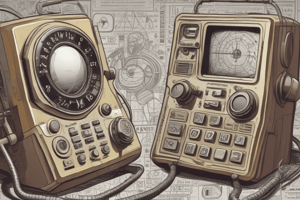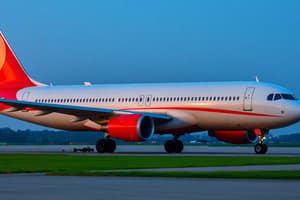Podcast
Questions and Answers
Phonetic numbers enhance ______ by ensuring numbers sound different from each other.
Phonetic numbers enhance ______ by ensuring numbers sound different from each other.
clarity
The phonetic alphabet is recommended by the international civil aviation ______ for air/ground communication.
The phonetic alphabet is recommended by the international civil aviation ______ for air/ground communication.
organization
Uniformity in phonetic numbers means that everyone uses the same ______ for numbers.
Uniformity in phonetic numbers means that everyone uses the same ______ for numbers.
words
Mishearing a number during communication can be ______ for pilots trying to land in difficult conditions.
Mishearing a number during communication can be ______ for pilots trying to land in difficult conditions.
If a pilot needs to repeat a message, they use the term ______.
If a pilot needs to repeat a message, they use the term ______.
The term ______ is used when confirming a message in radio communications.
The term ______ is used when confirming a message in radio communications.
To indicate a negative response, pilots will use the term ______.
To indicate a negative response, pilots will use the term ______.
When instructed to wait for further communication, pilots will use the term ______.
When instructed to wait for further communication, pilots will use the term ______.
Zero is pronounced as ______
Zero is pronounced as ______
In military time, if it is 12:00 A.M. at GMT, it is ______ A.M. in the Philippines.
In military time, if it is 12:00 A.M. at GMT, it is ______ A.M. in the Philippines.
ZULU time helps unify all regions around the world by eliminating the need for ______ and P.M.
ZULU time helps unify all regions around the world by eliminating the need for ______ and P.M.
The military time equivalent of midnight is ______ hours.
The military time equivalent of midnight is ______ hours.
To convert local time to Zulu time, you subtract ______ hours from local time in the Philippines.
To convert local time to Zulu time, you subtract ______ hours from local time in the Philippines.
The different categories of airspace include Class A, B, C, D, E, and ______.
The different categories of airspace include Class A, B, C, D, E, and ______.
In the airspace, areas used for military operations are known as ______ areas.
In the airspace, areas used for military operations are known as ______ areas.
Decimal is pronounced as ______ for the dot in numbers.
Decimal is pronounced as ______ for the dot in numbers.
A ______ is used for broadcasting two-way communication in the radio frequency range.
A ______ is used for broadcasting two-way communication in the radio frequency range.
The ______ allows for the radar to see aircraft altitude automatically when set to alt.
The ______ allows for the radar to see aircraft altitude automatically when set to alt.
The angle of an aircraft from the radar site is referred to as ______.
The angle of an aircraft from the radar site is referred to as ______.
The question 'WHO AM I?' is part of the ______ communication framework.
The question 'WHO AM I?' is part of the ______ communication framework.
Readability scale 5 indicates that the transmission is ______.
Readability scale 5 indicates that the transmission is ______.
A transponder-equipped flight is operated under an IFR flight plan and controlled directly by _____
A transponder-equipped flight is operated under an IFR flight plan and controlled directly by _____
You are required to set your altimeter to the standard setting of _____ inHg.
You are required to set your altimeter to the standard setting of _____ inHg.
You can’t fly when the weather is below VFR minimums unless you are _____ rated.
You can’t fly when the weather is below VFR minimums unless you are _____ rated.
CLASS B airspace is established to separate all arriving and departing _____ traffic.
CLASS B airspace is established to separate all arriving and departing _____ traffic.
CLASS G airspace is uncontrolled and typically extends from the surface up to _____ feet AGL.
CLASS G airspace is uncontrolled and typically extends from the surface up to _____ feet AGL.
A special VFR clearance allows you to operate within the surface areas of class B, C, D, and E airspace if the visibility is at least _____ statute mile.
A special VFR clearance allows you to operate within the surface areas of class B, C, D, and E airspace if the visibility is at least _____ statute mile.
CLASS C airspace is designated at certain airports where ATC is equipped to provide _____ service for all aircraft.
CLASS C airspace is designated at certain airports where ATC is equipped to provide _____ service for all aircraft.
The half moon principle in CLASS C airspace consists of two areas that extend outward from the primary airport: inner core and _____ shelf.
The half moon principle in CLASS C airspace consists of two areas that extend outward from the primary airport: inner core and _____ shelf.
A student pilot must possess a student pilot _____ to operate.
A student pilot must possess a student pilot _____ to operate.
VFR weather minimums require a visibility of _____ statute miles.
VFR weather minimums require a visibility of _____ statute miles.
In Class D airspace, two-way radio communication is required before _____ the airspace.
In Class D airspace, two-way radio communication is required before _____ the airspace.
The term _____ refers to a four-digit code assigned by ATC for aircraft identification.
The term _____ refers to a four-digit code assigned by ATC for aircraft identification.
The defined area under the VFR weather minimums includes cloud clearance of 1000 feet _____ and 500 feet below.
The defined area under the VFR weather minimums includes cloud clearance of 1000 feet _____ and 500 feet below.
Class E airspace has no specific _____ limits and does not require communication with ATC.
Class E airspace has no specific _____ limits and does not require communication with ATC.
A Mode C transponder is used to identify aircraft by _____ during flight.
A Mode C transponder is used to identify aircraft by _____ during flight.
VFR flights require maintaining 2000 feet of _____ clearance horizontally.
VFR flights require maintaining 2000 feet of _____ clearance horizontally.
Flashcards are hidden until you start studying
Study Notes
Phonetic Numbers and Their Uses
- Phonetic numbers ensure clarity in communication, preventing misinterpretation.
- Promotes uniformity in radio communications, as everyone uses the same phonetic terminology for numbers.
- Enhances accuracy in understanding numerical information, crucial in high-pressure situations like piloting in adverse weather.
Phonetic Alphabet
- ICAO recommends a standard phonetic alphabet for international aviation communications.
- Examples include:
- A - Alfa
- B - Bravo
- C - Charlie
- Z - Zulu (designates military time)
- Key numerical pronunciations:
- Zero as "Ze-ro", One as "Wun", Two as "Too", Three as "Tree", Nine as "Niner", Decimal as "Day-see-mal".
Zulu Time
- Zulu time, or Coordinated Universal Time (UTC), standardizes time globally, eliminating confusion between A.M. and P.M.
- The Philippines operates at UTC+8, meaning 12:00 A.M. GMT corresponds to 8:00 A.M. locally.
Categories of Airspace
- Airspace is classified into regulatory (Class A, B, C, D, E, G) and non-regulatory for organized traffic flow.
- Special areas include restricted and prohibited airspace, military operation areas, and controlled firing areas.
Types of Airspace
- Class B: Controlled airspace from ground to 10,000 feet MSL, requires two-way radio and a transponder.
- Class C: Radar service provided, two areas (inner core and outer shelf) with specific visibility requirements.
- Class D: Airports with ATC, requires two-way communication, extends to 2,500 feet AGL.
- Class E: Controlled airspace with no specific requirements; entry generally requires radio communication.
- Class G: Uncontrolled airspace with limited ATC involvement, often below 700 or 1,200 feet AGL.
VFR Weather Minimums
- Standard minimums for VFR (Visual Flight Rules) include:
- 3 statute miles visibility
- Cloud clearance: 1,000 feet above, 500 feet below, 2,000 feet horizontally.
Transponder Operation
- Transponders transmit identification codes to ATC, enhancing radar identification of aircraft flying under IFR (Instrument Flight Rules).
- Squawk Codes: Specific four-digit codes provided by ATC to identify aircraft, indicating various statuses (e.g., emergency, radio failure).
Communication Fundamentals
- Clear communication involves addressing the 4 W’s: Who you are calling, your identity, current location, and intentions.
- Readability Scale: Ranges from 1 (unreadable) to 5 (perfectly readable) to assess transmission clarity.
Radar and ATC Services
- Radar systems use radio waves to detect aircraft position and movement.
- Transponder modes:
- Mode A: Basic identification.
- Mode C: Provides altitude information.
- Mode S: Advanced, selective interrogation with multiple formats.
Critical Communication Practices
- Strong emphasis on the importance of communication among pilots and ATC to ensure safety and prevent misunderstandings.
- Use of phrases like "Say Again" for repetition and "Standby" for pausing conversations.
Studying That Suits You
Use AI to generate personalized quizzes and flashcards to suit your learning preferences.



